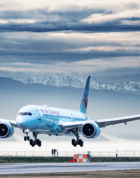After many months of alluding to this measure, Ontario Premier Doug Ford has announced today that the province will begin offering free voluntary COVID-19 tests at Toronto Pearson International Airport for international arriving passengers.
Importantly, unlike the Alberta rapid testing pilot project, the COVID-19 tests at Toronto Pearson currently will not allow travellers who test negative to bypass Canada’s mandatory 14-day quarantine upon return.
You can watch the press conference below:
Rapid Testing at Toronto Pearson
Beginning today, January 6, 2021, eligible international travellers at Toronto Pearson International Airport will have the option to take a free COVID-19 test upon their arrival.
To qualify for the test, the traveller must intend to remain within Ontario for at least 14 days. This means that if Toronto is your port of entry in Canada, but you’re heading elsewhere as your final destination, you won’t be eligible for the rapid testing.
Testing facilities will be available at both Terminal 1 and 3, and arriving passengers may register for a test either online at the Toronto Pearson website or in-person upon their arrival.
Travellers will be directed to a dedicated testing space, where they will self-administer the COVID-19 PCR test under guidance from a health care provider (either in-person or via video link).
Test results will be reported into Ontario’s Lab Information System and will typically be available within 48 hours. Local health authorities will follow up with any positive tests to remind them of their obligation to self-isolate.
Not an Alternative to the 14-Day Quarantine
Importantly, the rapid testing initiative at Toronto Pearson does not allow inbound travellers to bypass the federally mandated 14-day quarantine upon returning to Canada. Travellers who voluntarily take the COVID-19 test at YYZ will continue to be subject to the 14-day mandatory quarantine, even if their test results return negative.
Instead, it’s merely the first step towards such an outcome here in Ontario, similar to what has already been implemented in Alberta. Ontario is continuing to work with the federal government to offer a modified quarantine period for travellers who test negative upon their arrival in Canada.
Moreover, the testing initiative at Toronto Pearson also does not replace the new requirement for all travellers flying to Canada to present a negative COVID-19 test taken within 72 hours prior to boarding, which kicks in as of tomorrow, January 7.
To summarize, if you’re flying home from another country into Toronto:
- You must present a negative test prior to your flight.
- Then, you have the further option of taking another test upon arrival.
- Regardless of whether you test positive or negative, you must still complete a 14-day quarantine.
What Do I Make of This Measure?
I’ve been keenly anticipating the introduction of rapid testing for inbound travellers at Toronto Pearson International Airport. When considered on its own, I’m happy that the testing initiative is finally being implemented after months of speculation.
However, I had a feeling that the rapid testing would not be accompanied by an easing of the 14-day quarantine here in Ontario similar to what we’ve seen in Alberta, purely due to the role of travel in the current political climate.
Travellers are an easy scapegoat at the moment, receiving a disproportionate level of blame in the press for the rising cases, and so I suspected that any new measures would likely only make things more complicated for travellers, not easier. Indeed, the introduction of rapid testing without a corresponding modified quarantine plan for travellers who test negative is quite telling in that regard.
Even then, there’s no denying that the availability of free and voluntary tests at Toronto Pearson will be beneficial in some ways.
For example, if you’re quarantining at home with other household members, then a negative test upon entering Canada may provide some reassurance that it’s safer to interact with other household members if necessary.
There’s also continued benefits on the research side, as greater testing of inbound travellers can inform further policymaking about the effectiveness of testing vs. quarantine measures as a means to protect against travellers bringing the virus into Canada from abroad.
However, the more time goes by, the more I feel that some tough questions need to be asked. First of all, with no option to bypass the 14-day quarantine, is there any meaningful incentive for most travellers to undergo testing at Toronto Pearson?
Secondly, is it truly an optimal use of resources to offer an optional test upon arrival on top of both a pre-boarding negative test and a 14-day quarantine?
As it relates to these two measures, Ontario Health Minister Christine Elliott describes Toronto Pearson’s airport testing as merely “another layer of protection for our communities”. We heard the same thing back when Canada’s pre-flight testing requirement was haphazardly announced. How many layers of protection do we truly need, if these layers don’t also contribute to making our lives easier?
At what point are these measures being implemented for the optics of it all, in light of the recent furor over non-essential travel, rather than towards the actual desired outcome of striking a balance between living our lives and containing the virus?
And don’t get me wrong: if the objective is in fact purely to contain the virus while giving up any semblance of balance in our lives for a short period (as many countries did early on in the pandemic), I can accept that as well.
But if that’s the case, then where’s the strict enforcement on the quarantine rules? And why are arriving passengers being invited to perform a self-administered test, which is certainly less likely to be carried out properly than one administered by a medical professional?
We can’t have it both ways: we either need strictly enforced containment measures, or we need science-informed measures that mitigate risks as we learn to live with the virus.
Other countries have done well with one or the other – but based on the current trend, it seems like we still have a long way to go here in Canada. An enhancement of the Toronto Pearson testing initiative to offer a reduced quarantine for negative tests would be a welcome step along that journey.
Conclusion
As of today, eligible international travellers flying into Toronto Pearson International Airport will be able to take a free and voluntary COVID-19 test upon arrival. The testing initiative does not replace the 14-day quarantine or the requirement to present a negative test before your flight to Canada.
Ontario is working with the federal government to offer a modified quarantine for travellers who test negative, with Doug Ford mentioning during the press conference that he hopes to have “good news in the coming days”, and we can only hope it gets implemented sooner rather than later.




















PCR tests run at over 25 cycles generate MASSIVE quantities of false positives. Canada runs them at 35 and sometimes higher. Even the WHO has admitted the tests are unreliable and the inventor of the tests, Kerry Mullis, said they were ineffective as a diagnostic tool. In short, PCR tests do nothing to prevent the spread of Covid…NOTHING…but they are really good at allowing the lying politicians to justify destroying Canada’s economy and trampling Canadians’ Charter rights.
The whole situation is stupid. We’ve had 9 months to build additional hospitals, get more medical staff (students, military medical, Doctors and Nurses who are already here but without their credentials recognized) all to alieviate the ICU issues. Remember that ICU’s are already always running at 90% before Covid (you always have to wait hours to get in to emerg). That is the only issue. Lets Just Hope this announcement is followed very Soon with an Alberta style policy; unless you’re 70+ years old or severely compromised which is the demographic where Covid is deadly. Doug Ford -1
A negative Covid test 72 hrs prior to departure is no guarantee of being Covid free, a person may have been exposed prior to testing but not yet have detectable levels of the antigen, or get infected after testing. A combination of testing prior to departure and on arrival would be better but still no guarantee, so quarantine would still be needed to prevent any spread. Unfortunately there are idiots that break quarantine. While the vast majority of transmissions are within the community it was travel that brought Covid out of China. If Canada and other countries had adopted the Taiwan and New Zealand restrictions and tracing systems we would have been in much better shape.
the most important question: does it cancel the need to undergo a COVID pre-flight test before boarding a flight from any international destination to Toronto?
If yes – than it is a blessing (a cost of pre-flight COVID test in Cancun is about $250 USD per person – so canceling this pre-flight requirement would save a lot of money to the travelers).
As stated in the article, the answer is unfortunately no.
Then this test is only to satisfy anyone who is curious.
I wouldn’t waste even 1 minute to detour on my way home from Pearson.
The results of this test are irrelevant – if there is absolutely no incentive.
I question any branding of this or the Alberta initiative as ‘rapid’ since it doesn’t use ‘rapid’ test technology. There are rapid tests on the market (albeit not as accurate at PCR) in use by some airlines and governments elsewhere who recognize the speed of result makes them a useful risk reduction tool. Surely a rapid test administered by a professional is better than a self-administered PCR.
Might I add that Ford calling this a ‘game-changer’ is laughable
Trudeau’s handling of this file is “laughable.”